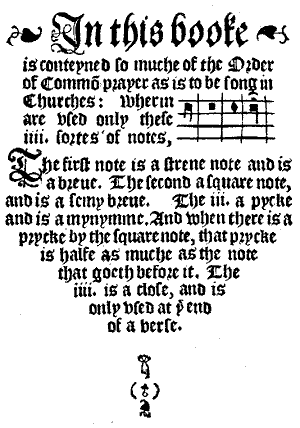Merbecke Te Deum in chant notation
-
You’d need a score capable of representing the different note values used in all the music from Merbecke’s Booke of Common Praier Noted. Equalist renderings of these works are serious debasements of what the composer wrote.
 Thanked by 1CHGiffen
Thanked by 1CHGiffen -
Care to share a mensuralist rendering then?
I was under the impression that Merbecke's note values were merely a guide to good speech rhythm, something which 400 years and a plainchant revival later is better represented by square notes.
I have made good use of the Tozer transcriptions of du Mont, so if something similar for Merbecke exists, I'd be glad to see it. -
This could found in Merbecke's The Prayer Book Noted, if one could find such from Amazon, etc.
Merbecke noted the entire PB, including the offices and their canticles, &cet. -
Several accurate, attractive, highly readable semi-facsimile editions were published in the nineteenth century. Unfortunately, all the color scans of these I’ve seen online use originals with very discolored paper. I imagine that someone good with image editing software could overcome this.
Merbecke could have used all-square-note notation had he wanted, but went to the trouble carefully to explain his use of measured notes. -
Tangent: I do wish that English-speaking bishops' conferences would permit the Sung use of traditional English texts (thee, thy, thou), especially considering the Ordinariate Use, in the Novus Ordo. Provided that the texts were accurate (the BCP "Sanctus" with the text taken from the Te Deum rather than the Latin Sanctus could be a problem), it would be nice to be able to use parts of Stanford and Wood, to say nothing of Merbecke, from time to time: as they were written, rather than adapted to ICEL2010. Here endeth the tangent.
-
I was today years old when I learned that Merbecke wrote a second setting of the Sanctus for use at a requiem Mass (with a text that differs slightly from the text of the Sanctus found in the communion rite, and is closer to our current English translation). He also wrote a requiem Kyrie and Agnus Dei. I wonder if anyone ever sings these?Thanked by 1Joseph Michael
-
.
-
For completeness' sake on this old thread, I transcribed the Merbecke Te Deum from Accompanying harmonies to the Canticles, pointed and adapted to the Gregorian tones, etc by James Black Gray (1865). Perhaps the attached might be useful to someone.

 Merbecke - Te Deum.pdf61K
Merbecke - Te Deum.pdf61K
Welcome to the MusicaSacra Forum!
To participate in the discussions on Catholic church music, sign in or register as a forum member, The forum is a project of the Church Music Association of America.
Categories
- All Discussions21,096
- General Music Discussion8,211
- Job Openings197
- Management of Music Programs850
- Choral Matters532
- Church Documents and Rubrics524
- CMAA Notes301
- Events716
- For Newcomers: Read First26
- Sacred Polyphony546
- Hymnody872
- Gregorian Chant: General2,697
- ↳ Graduale Romanum and Liber Usualis368
- ↳ Graduale Simplex60
- ↳ Semiology63
- Vernacular Plainsong696
- Anglican Use and Anglican Chant68
- Organ, Other Instruments and Repertoire435
- New Composition/Works in Progress1,290
- Recordings230
- Music for Hispanic Ministry159
- Music Education: Children211
- Music Education: General222
- News Items245
- Positions Wanted2
- General Discussion: Catholicism739
- Amusements177
- General Discussion1,033
- Opinions117




